 Open Access
Open Access
ARTICLE
BLECA: A Blockchain-Based Lightweight and Efficient Cross-Domain Authentication Scheme for Smart Parks
School of Computer and Electronic Information, Guangxi University, Nanning, 530004, China
* Corresponding Author: Ruwei Huang. Email:
Computers, Materials & Continua 2023, 77(2), 1815-1835. https://doi.org/10.32604/cmc.2023.041676
Received 01 May 2023; Accepted 13 September 2023; Issue published 29 November 2023
Abstract
Smart parks serve as integral components of smart cities, where they play a pivotal role in the process of urban modernization. The demand for cross-domain cooperation among smart devices from various parks has witnessed a significant increase. To ensure secure communication, device identities must undergo authentication. The existing cross-domain authentication schemes face issues such as complex authentication paths and high certificate management costs for devices, making it impractical for resource-constrained devices. This paper proposes a blockchain-based lightweight and efficient cross-domain authentication protocol for smart parks, which simplifies the authentication interaction and requires every device to maintain only one certificate. To enhance cross-domain cooperation flexibility, a comprehensive certificate revocation mechanism is presented, significantly reducing certificate management costs while ensuring efficient and secure identity authentication. When a park needs to revoke access permissions of several cooperative partners, the revocation of numerous cross-domain certificates can be accomplished with a single blockchain write operation. The security analysis and experimental results demonstrate the security and effectiveness of our scheme.Keywords
Intelligent devices have increased alarmingly with the development of the Internet of Things (IoT) and the advent of the 5G era [1]. Promoting the development of smart cities through IoT and cloud computing technology is a research hotspot nowadays [2]. Smart parks, as microcosms of smart cities, play an integral role in the era of innovation. Although extensive network infrastructure enables devices from various parks to interconnect, quite a few trust and security challenges have not been resolved [3]. Establishing secure communication for devices across different domains is still a crucial task.
Most of the existing identity authentication mechanisms are built upon the widely recognized Public Key Infrastructure (PKI) system, which involves a Certificate Authority (CA) [4]. The PKI system verifies the certificate to authenticate the identity of devices [5]. Traditional PKI-based cross-domain authentication schemes can be categorized into two types. The first type involves the introduction of a trusted third party, namely the root CA, to serve as a trust center for all domains. However, if the root CA is compromised, the entire authentication system becomes paralyzed, leading to significant economic losses. The second type is inter-domain mutual authentication through the exchange of certificates between CAs. This authentication model results in overly complex authentication paths and escalates the cost of cross-domain cooperation. The traditional PKI-based cross-domain authentication schemes heavily rely on CAs, making them susceptible to the risk of single point failures [6].
The thriving blockchain technology offers a new solution to solve the security problem of IoT [7,8]. Blockchain possesses attributes like decentralization, tamper-proof, and data traceability, which can establish trust in an untrusted environment [9,10]. Blockchain has found widespread utility as a foundational technology for multi-party solutions [11,12]. The consortium blockchain is a kind of distributed ledger (DL) maintained by multiple cooperative peer nodes [13]. When multiple CAs collectively construct a consortium blockchain, they can realize decentralized certificate management and ensure reliable cross-domain trust transfer. This approach mitigates the risk of single point failures, and streamlines the complexity of cross-domain authentication processes [14,15].
In recent years, numerous scholars have leveraged consortium blockchain for cross-domain identity authentication [16–22]. Qiao et al. [23] devised an efficient cross-domain authentication scheme for the drone transportation industry by integrating consortium blockchain and PKI. Similarly, Rana et al. [24] employed blockchain technology to create a decentralized access control model for various healthcare sectors, enhancing interoperability among distinct industry systems. The solutions provided in [23,24] demand uniform identity management standards across all industries, which are not suitable for application in a range of industries with varying security levels. A smart park alliance is a cooperative mechanism aimed at fostering collaboration among various parks, promoting urban sustainability, and facilitating digital transformation. Members of smart park alliances may include government departments, urban planners, technology suppliers, businesses and industry groups, as well as social organizations. The security management of each park is typically different. Therefore, there is a need for a certificate management scheme that enables each park to issue and revoke cross-domain certificates in alignment with its specific security level. While many cross-domain authentication schemes address the requirement for autonomous certificate management by issuing cross-domain certificates to devices, the maintenance cost of multiple cross-domain certificates renders them impractical for resource-constrained devices. Moreover, large-scale enterprise parks typically oversee thousands of devices, and collaborative relationships between different organizations often undergo changes. In scenarios where an industrial park needs to terminate its cooperative relationship with other parks or replace a cooperative logistics company, existing solutions require substantial expenses to revoke cross-domain certificates for all relevant devices.
In order to solve the above problems, we proposed a blockchain-based lightweight and efficient cross-domain authentication scheme for smart parks (we call it BLECA). In contrast to the aforementioned cross-domain authentication schemes, BLECA provides a lightweight cross-domain authentication protocol and a practical certificate revocation mechanism specifically designed for smart parks. This solution not only guarantees cross-domain connectivity for resource-constrained devices but also enables each park to flexibly and cost-effectively revoke cross-domain identities according to its individual security requirements. The main contributions of this paper are as follows:
(1) We introduce a cross-domain authentication architecture based on the consortium blockchain, which consists of CA in each smart park. A smart contract for establish trust chains is deployed in the blockchain, allowing each park to dynamically adjust its partnerships.
(2) Drawing from the attributes of blockchain technology, this paper designs a low-cost, simplified cross-domain authentication and key agreement protocol. The protocol figures out the device’s cross-domain certificate according to the device’s intra-domain certificate and CA identity of the cross-domain park, enabling resource-constrained devices to maintain only one intra-domain certificate.
(3) We devise a complete certificate revocation mechanism for the dynamic partnership between parks. First, the device cancellation algorithm utilizes the trust chain to identify the relevant cross-domain certificates associated with the device that needs to be logged out, and revokes them synchronously, thereby enhancing system security. Secondly, the cross-domain certificate batch revocation feature is formatted in accordance with the requirement for terminating part of the partnerships. Only one blockchain write operation is required to revoke all relevant cross-domain certificates, which substantially reduces computational overhead and saves storage resources.
Organization: The remainder of this paper is organized as follows: Section 2 reviews the related work of cross-domain authentication based on blockchain. Section 3 introduces the system model and related theoretical knowledge. Section 4 elaborates on the design specifics of the proposed scheme, and Section 5 presents a security analysis. Section 6 includes extensive experiments and discussions to showcase the effectiveness of BLECA. Finally, Section 7 concludes the work.
In this section, we begin by summarizing some basic knowledge of blockchain and smart contracts. Subsequently, we provide a comprehensive overview of recent research in blockchain-based identity authentication.
2.1 Blockchain and Smart Contract
Blockchain, initially proposed by Satoshi Nakamoto, is a distributed ledger system where data is managed in the form of blocks by a cluster of distributed computers [25]. Each block contains a block header and transaction data. The block header, including the hash value of the previous block, the hash value of the current block, and the timestamp, is used to link the previous block and calculate the hash value of the current block to ensure the continuity and tamper resistance. There are two common categories of blockchain: permissionless blockchain and permissioned blockchain. The first type refers to public blockchain, which allows any member to join freely. It always selects some competitive schemes as consensus protocol, such as Proof of Work (PoW), Proof of Stake (PoS), and Proof of Activity (PoA) [26–28]. The second category encompasses private blockchain and consortium blockchain. It only chooses trustful actors as peer nodes and usually adopts typical Crash Fault Tolerance (CFT) or Byzantine Fault Tolerance (BFT) consensus protocols. BFT is designed to ensure the fault tolerance and security of distributed systems by overcoming Byzantine faults like node failures, network delays, message loss, and malicious behaviors, enabling the system to reach a consensus in the face of these problems. Before transaction data is added to the blockchain, it must be confirmed by the consensus mechanism, ensuring the credibility and security of the data. Through the above-mentioned data organization method, the blockchain realizes the characteristics of decentralization, security, transparency and immutability, which can be used for credible reading and writing in distributed environments [29].
Practical Byzantine Fault Tolerance (PBFT) and Tendermint are consensus protocols based on the principles and ideas of BFT, which are currently widely used in the consortium blockchain. Both protocols can tolerate no more than 1/3 of malicious nodes to ensure that the system has strong fault tolerance to Byzantine faults. PBFT consensus requires three rounds of voting, including the pre-prepare, prepare, and commit phases. The Tendermint consensus uses a “proposal-vote” mechanism that involves only two rounds of voting, namely the pre-vote stage and the pre-commit stage, reducing the complexity of message transmission and the consensus process. Tendermint offers higher throughput and lower latency, making it more suitable for large-scale network applications that demand high-performance consensus. Peer nodes of the consortium blockchain are verified entities, resulting in fewer instances of malicious behavior. Smart park alliances generally only allow qualified organizations to join, hence it is more appropriate to select the consortium blockchain with Tendermint consensus protocol for large-scale park alliances.
The users can perform customized programs stored on the blockchain. When certain transactions invoke the predetermined functions, the program will automatically run [30]. These customized programs go by different names on various blockchain platforms. For example, on the Ethereum platform, they are referred to as smart contracts, on the Hyperledger Fabric platform, they are called chaincode, and on the Tendermint platform, they are known as ABCI applications. Since Ethereum platform is the most widely used, we commonly use “smart contract” as the generic term for customized blockchain programs.
2.2 Cross-Domain Authentication Based on Blockchain
The research of identity authentication based on blockchain has garnered the attention of many research institutions [31,32]. In 2014, the Conner team of MIT proposed the first blockchain-based identity authentication system for certificate management [33]. Kshetri [34] asserted that blockchain offers significant advantages in facilitating identity management and access control for IoT, which can enhance IoT security. Rana et al. [35] discussed the significance of blockchain in the context of IoT and introduced a specialized blockchain-based architecture for IoT networks. Dave et al. [36] presented a blockchain-based video surveillance framework designed for smart home environments. This framework utilizes smart contracts to define authentication levels and access rules for video footage, ensuring that only authorized users can access surveillance recordings.
Zhou et al. [16] and Huang et al. [17] established consortium blockchains consisting of several PKI organizations and developed cross-domain authentication protocols. Nevertheless, these two schemes retain the process of traditional identity certification, resulting in relatively complex authentication paths. Zhao et al. [18] proposed a double-layer cross-domain authentication architecture composed of authentication server nodes and several internal blockchains, enhancing the scalability of the PKI system without altering the internal structure. However, for the authentication schemes proposed by [16–18] necessitate devices to manage multiple cross-domain certificates, rendering them unsuitable for lightweight devices with limited storage capacity. In [19], the authors designed a cross-domain authentication and session key agreement protocol, enabling devices to manage just one certificate for authentication across all other domains. Nonetheless, in this scheme, each domain is unable to flexibly define its certificate management standards, potentially posing a security risk to the system. In [20], researchers designed a thoroughly cross-domain authentication scheme based on blockchain, accommodating participants from domains with entirely different configurations. But its authentication process requires the blockchain to perform intensive signature verification and hash calculation. Furthermore, none of the aforementioned studies offer an effective certificate revocation mechanism.
Gu et al. [21] proposed a blockchain-based authentication and certificate revocation scheme. In this scheme, revoked certificate records are appended to the certificate revocation list stored in the DL for the query. However, the certificate revocation mechanism of this scheme is relatively intricate, and the accumulation of revocation records can significantly impact authentication efficiency. Wang et al. [22] introduced a multi-CA authentication model based on blockchain. They designed a cross-domain certificate revocation mechanism using the Poisson distribution of the cross-domain access list. However, it requires substantial system resources to execute device revocation, and the related cross-domain certificates cannot be revoked synchronously.
While these blockchain-assisted cross-domain authentication schemes have achieved reliable authentication across multiple domains to some extent, they have not addressed the issue of certificate management for resource-constrained devices in multi-domain environments with varying security management settings. Furthermore, the existing certificate revocation mechanisms have not met the requirement for synchronously revoking all certificates when a device is deregistered and the bulk revocation of cross-domain certificates due to changes in inter-domain collaboration. Therefore, the current authentication schemes are not suitable for dynamic collaborative scenarios among smart parks with different security levels.
Novelty: The principal novel aspect of this article is that an effective blockchain-based cross-domain authentication scheme is proposed to meet the collaboration requirements among smart parks with varying security levels. Specifically, the distinctions from existing solutions are as follows: 1) The smart contract for managing cross-domain trust chains facilitates each park to flexibly adjust its collaborative relationships. 2) The process of cross-domain authentication and key negotiation is formulated, allowing each park to issue cross-domain certificates according to its security management regulations without adding to the certificate management burden of resource-constrained devices. 3) Utilizing the cross-domain trust chain as a foundation, we present an effective certificate revocation mechanism consisting of three algorithms: device cancellation, single cross-domain certificate revocation, and cross-domain certificate batch revocation. This mechanism further guarantees that each park can efficiently carry out certificate revocation tasks in different scenarios aligning with its own security standards.
This section provides a summary of symbols used in the BLECA scheme, as presented in Table 1. Subsequently, the system model is described, followed by an introduction to the relevant technologies employed in this scheme.

The cross-domain authentication model of the proposed scheme is shown in Fig. 1.
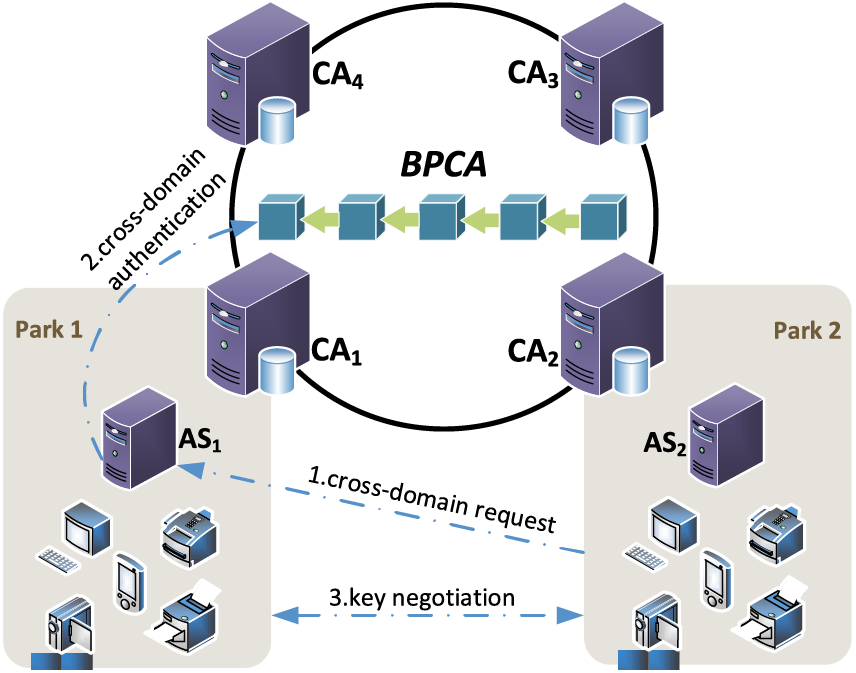
Figure 1: System model
(1)
(2)
(3)
(4)
In the proposed scheme, each park can autonomously maintain its own cross-domain trust relationships. The CA of each campus establishes its cross-domain trust chain according to its specific operational requirements. The trust chains of all domains collectively form an editable directed graph, as illustrated in Fig. 2. The vertexs in this graph represent the parks that join the consortium blockchain. Each park can only maintain its indegree edges. In Fig. 2, the value
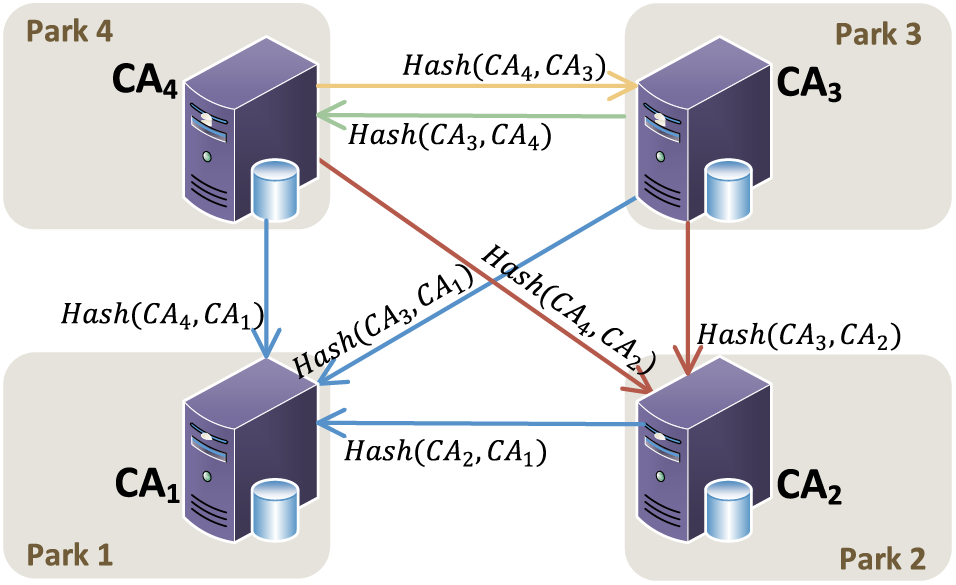
Figure 2: Editable cross-domain directed graph
3.2.1 Computational Hard Assumptions
While constructing the scheme, we rely on two computational difficulties assumptions. The detailed definition is presented as follows:
Elliptic curve discrete logarithm (ECDL) assumption: Given an element
Elliptic curve computational Diffie-Hellman (ECCDH) assumption: Let
A secure hash function [37] should possess the following three properties, where X represents the sets of all possible messages and Y represents the sets of all potential hash values.
Preimage stability: Given hash function
The second preimage stability: Given hash function
Collision-resistance: Given hash function
A generic digital signature scheme consists of a set of probabilistic polynomial-time algorithms
Key generation algorithm
Signing algorithm
Verification algorithm
Correctness. For every
Security. The security of the elliptic curve-based signature scheme relies on the computational complexity of ECDL assumption.
4 Design of the Proposed Scheme
The system initialization phase is carried out by all domains, as described below:
(1) Basic initialization: Every domain picks an elliptic curve
(2) Initialization of trust chain: Every CA sets its indegree edges. This process is called initialization of trust chain, as shown in Algorithm 1, where

The smart device
Step1:
Step2:
After receiving the registration request from
Step3:
If the identity signature of
4.3 Cross-Domain Authentication and Session Key Agreement
Devices can apply for cross-domain certificates from the authentication server nodes of cooperative parks. For example, if a device

When the device
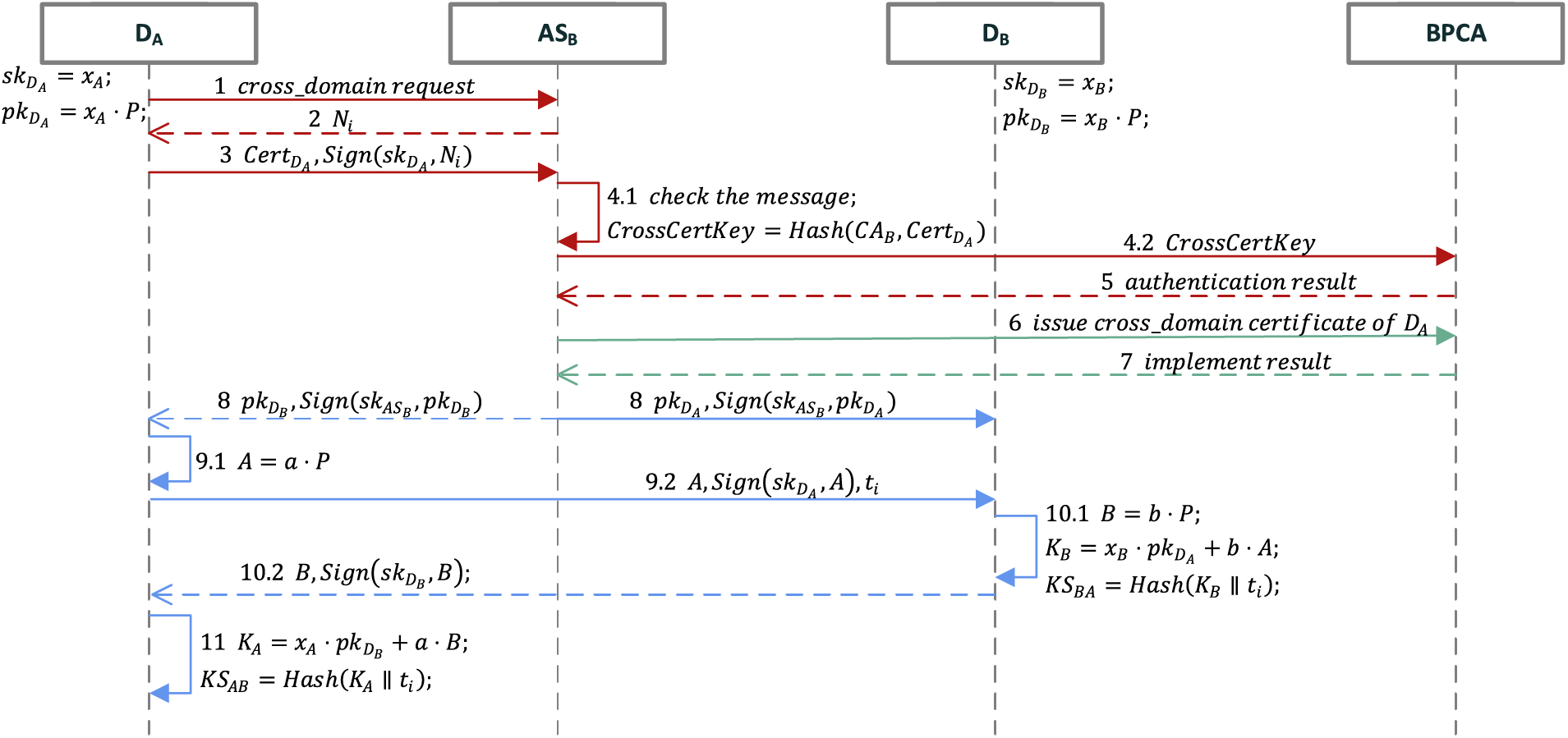
Figure 3: The process of cross-domain authentication and session key agreement
Step1:
Step2:
After receiving the request,
Step3:
Step4:
First,
Step5:
Algorithm 3 depict the cross-domain authentication function deployed in the blockchain. It will return the result to
(a) If the query result is empty, it means that
(b) If the status of
(c) If the status of

Step6:
First,
Step7:
After receiving the request,
Step8:
Receiving the successful authentication result returned by
Step9:
Step10:
If
Step11:
If the identity signature of the
Correctness: From the above equations, we can get Eq. (1).
Thus, we obtain
When a device needs to be canceled, the cross-domain certificates associated with the device should be revoked simultaneously to enhance system security. Taking the device
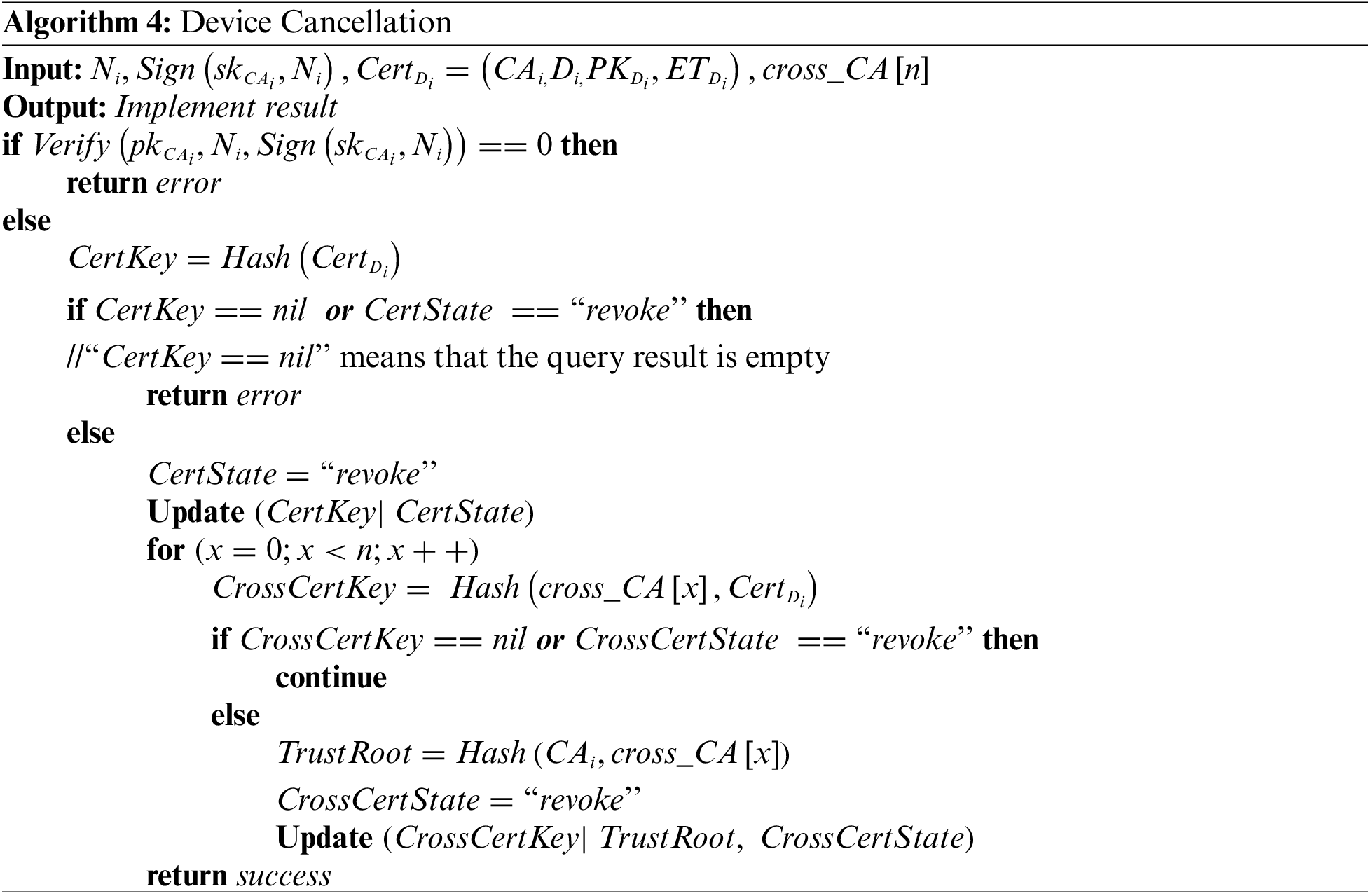
4.4.2 Single Cross-Domain Certificate Revocation
The revocation of a single device certificate typically occurs in the following two situations. If
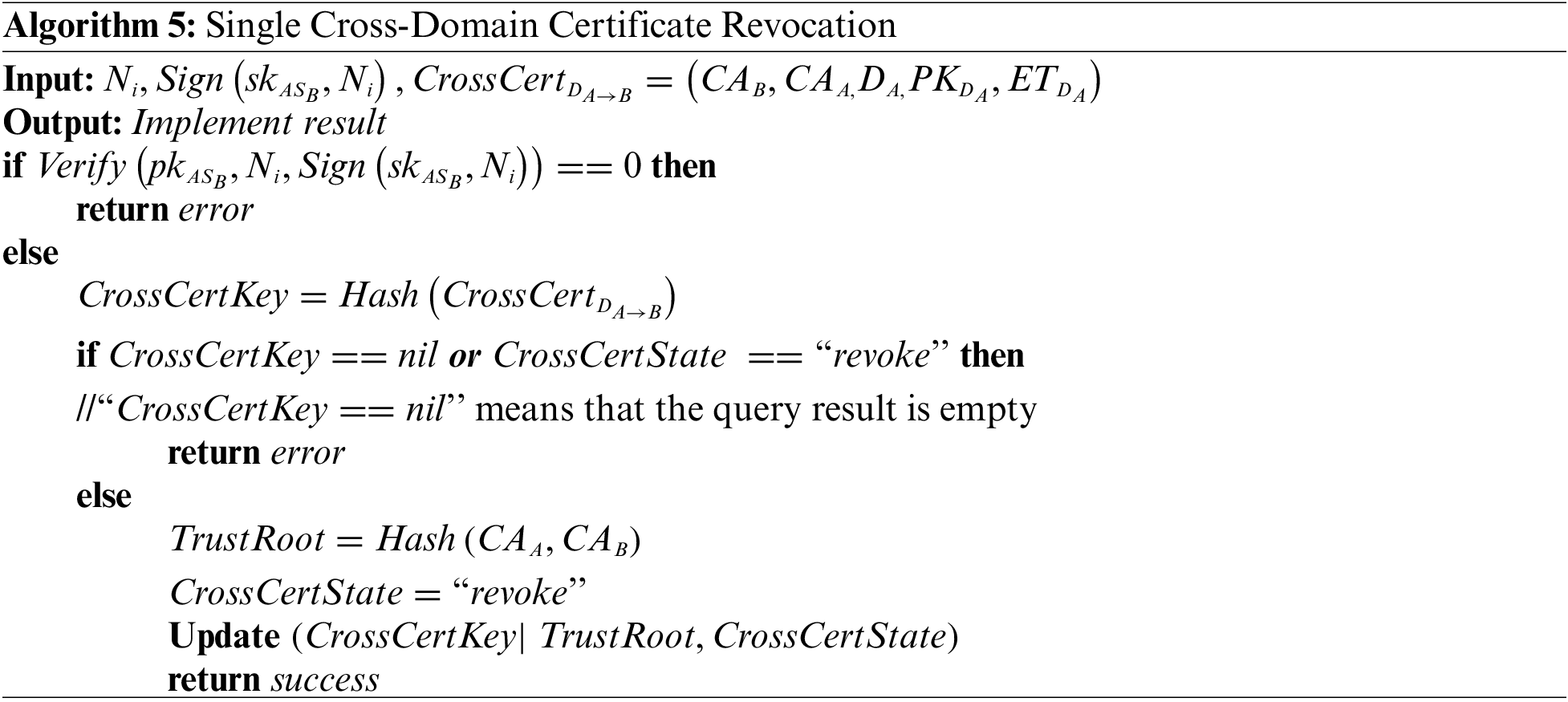
4.4.3 Cross-Domain Certificate Batch Revocation
According to Section 4.3, the
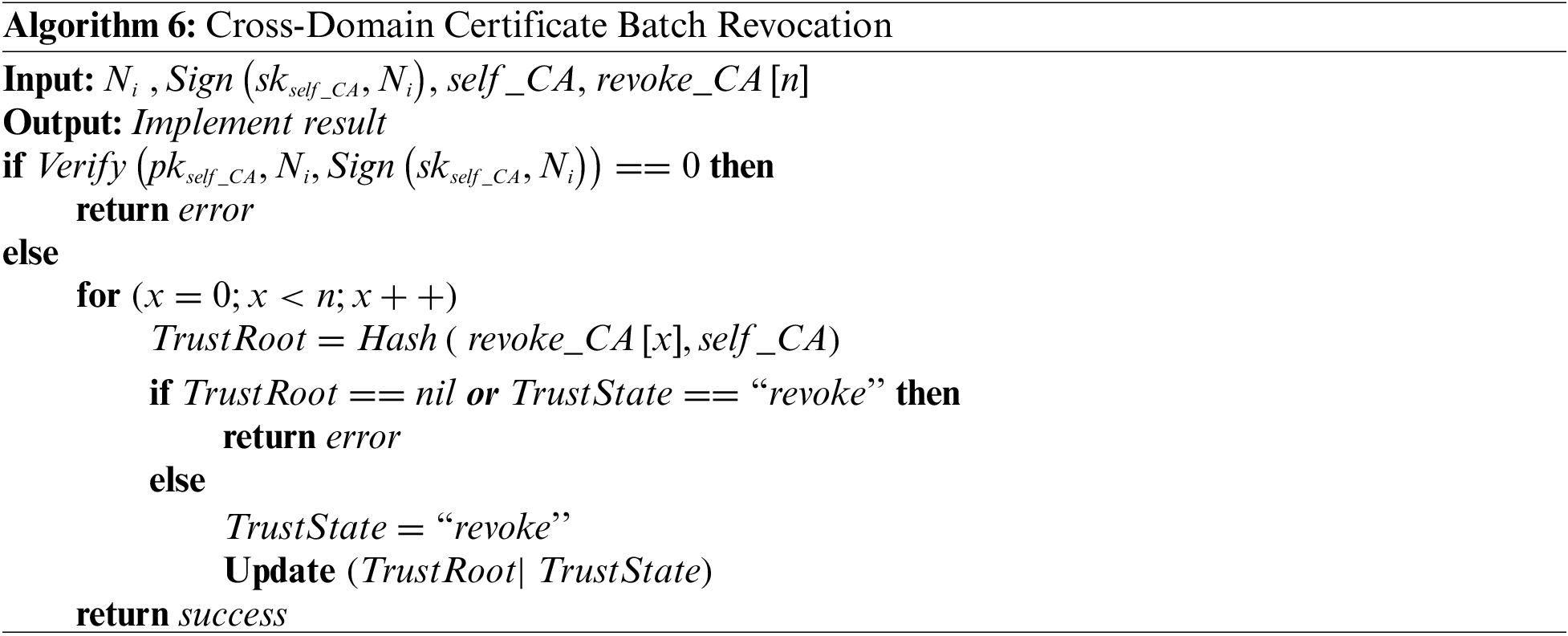
This section will provide a detailed explanation of how the BLECA scheme satisfies several standard security requirements for identity authentication.
5.1 Distributed Denial of Service (DDoS) Attack
DDoS Attack refer to multiple attackers located in different locations simultaneously launching attacks on one or more targets, or an attacker taking control of multiple machines located in different locations and utilizing these machines to simultaneously attack victims. This scheme uses consortium blockchain with Tendermint consensus mechanism as a distributed database. For every write transaction, all peers will receive them and save the data in the DL. Unlike traditional identity authentication solutions that rely on a central node, this scheme operates differently. Even if some nodes come under attack, the blockchain network can continue to function normally as long as the number of failed nodes is less than 1/3. When the paralyzed nodes is restored, it can retrieve the complete ledger from other nodes and resume its role as a normal node with a cross-domain authentication function. If the attacker tries to manipulate the system, it needs to control the computing power of
The authentication scheme of this paper adopts the question-response handshake mode, which integrates a random number along with a timestamp to ensure timeliness during message transmission. Receiving the cross-domain request of a device, the authentication server node will generate a random number
5.3 Man-in-the-Middle (MITM) Attack
The man-in-the-middle attack aims to intercept regular network traffic, sniff, and tamper with data without the knowledge of both parties. Suppose the attacker intercepts the random number
Authorized users within the network can query the information about certificates stored in the DL. An insider attack occurs when an authorized user within the network behaves as an attacker by leaking certificates, thereby posing a threat to the system’s security. In our scheme, the data stored in the DL is the certificate’s hash value rather than the certificate’s metadata. Due to the hash function properties described in Section 3.2, it is virtually impossible for an attacker to deduce certificate metadata from the hash value. As a result, this scheme exhibits resistance to internal attack.
A secure session key agreement protocol is designed for communication between two devices. The value a and b are secret keys selected by both sides of the communication, so attackers cannot obtain these values. Attackers would need to break the ECCDH assumption to figure out the session key. The exchanged messages A and B are one-time keys, which ensure the forward secrecy of the session. In the event of a leak of the private keys of both parties, the session key
6.1 Security and Functionality Performance Comparison
In this subsection, we choose some critical features to compare the scheme BLECA with Zhou et al. [16], Zhao et al. [18], Gu et al. [21], and Wang et al. [22]. As shown in Table 2, it is evident that BLECA is the only scheme that supports all of these features.

The aforementioned five schemes meet the basic security requirements, such as resisting DDoS attacks, replay attacks, MITM attacks, and internal attacks. Besides, BLECA provides a secure session key agreement mechanism to ensure the forward secrecy in communication. In the scheme proposed by Gu et al. [21], a device is only required to maintain one certificate, but this certificate also serves as a cross-domain certificate for other domains. As a result, this scheme is not suitable for scenarios where each park has different certificate management standards. In contrast, the cross-domain certificates in [16,18,22] are independent. However, devices in the studies [16,18] need to preserve
Chen et al. [39] conducted performance evaluations of certain cryptographic operations used in the relevant protocols on both smartphones and desktop computers to simulate resource-constrained terminal devices and authentication servers. The smartphone is equipped with Android 10.0 system, HUAWEI Kirin 980 2.6 GHz CPU, and 6 GB RAM, while the computer has Windows 10 system, Intel (R) Core (TM) i5-7300 HQ 2.5 GHz CPU, and 8 GB RAM. The computational capabilities of the current devices from smart parks are similar to these types of devices. Therefore, when evaluating the computation costs of different solutions, we refer to the measured times of some cryptographic operations reported by Chen et al. [39]. Table 3 summarizes some of their experimental results. Most computation and communication overhead are incurred during the authentication period, so we ignore the cost of system initialization and certificate issuance. Our primary focus is on comparing the cost of cross-domain authentication. Table 4 provides a summary of the comparison between BLECA and the other four schemes. The computation cost of BLECA is equal to that of the scheme [16,18,21]. Compared with the scheme [22], BLECA places a slightly lower computational burden on devices. Furthermore, our scheme requires one less communication interaction than the other four schemes, which reduces communication costs. It can be seen that our scheme is the most lightweight among the mentioned schemes.


For reference, we categorize the operations involved in the contracts of
We conducted four sets of experiments to assess the performance of query and write operations across different numbers of domains (4, 8, 12, and 16). We employed the thread group of Apache-Jmeter-5.5 to simulate client connection requests and collected the throughput and average delay data using performance listener of Jmeter. Initially, we measured the average latency for both write and query operations with one request, as shown in Table 5. Then, we focused on performance metrics by increasing the number of concurrent requests within 1 s. For query operations, the number of requests increases from 100 to 1000, and the test result of average latency is shown in Fig. 4. In the case of write operations, the number of requests increases from 50 to 500, and the corresponding results are presented in Figs. 5a and 5b. Each condition was tested ten times, and the average values were recorded for the results.

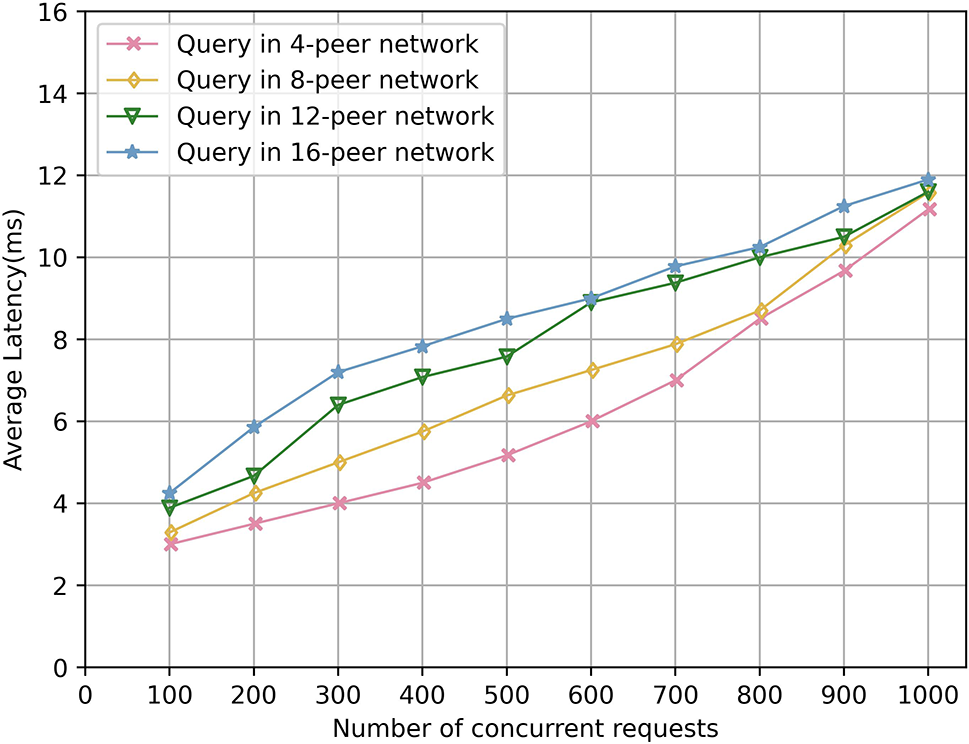
Figure 4: Average latency of query operation
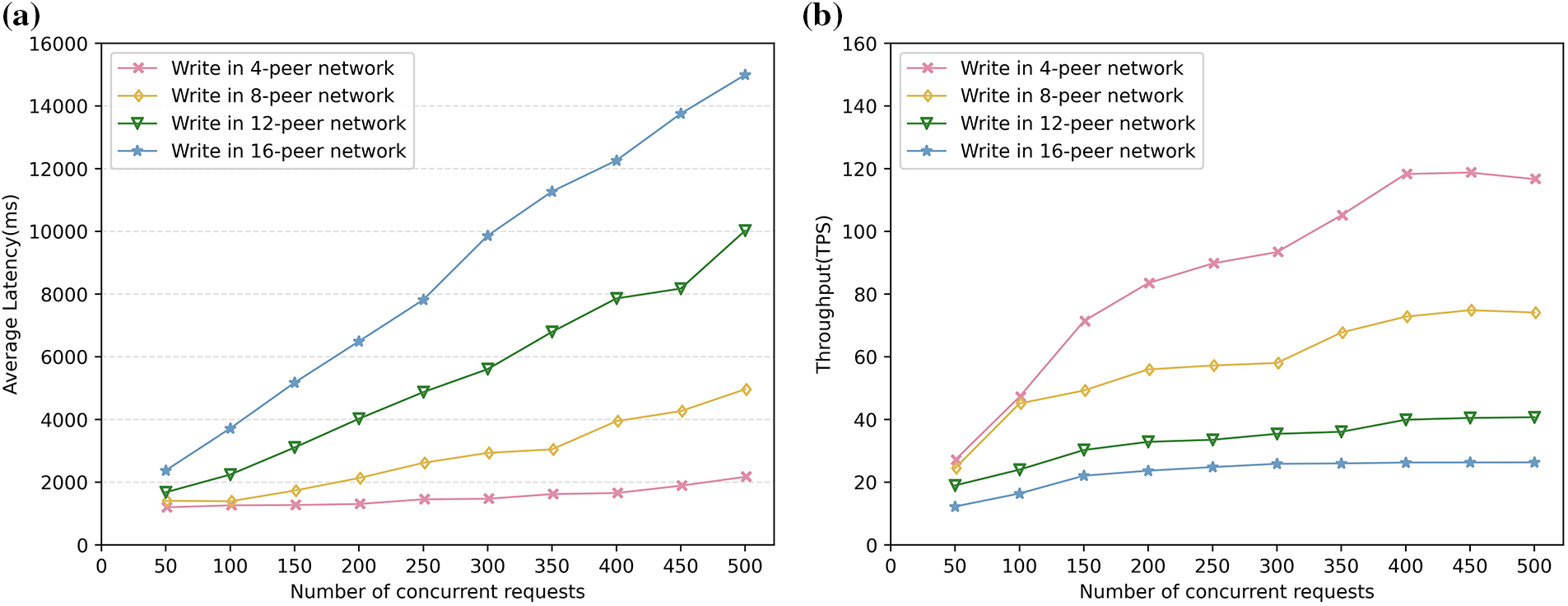
Figure 5: (a) Average latency of write operation. (b) Throughput of write operation
Performance of query operations: Table 5 and Fig. 4 reveal that the average delay of query operations is not affected by the number of peers. Similar findings were also testified in the experiments conducted by [20,22]. This observation shows that scaling up the number of parks within the collaborative alliance has no discernible impact on the performance of the cross-domain authentication protocol. Fig. 4 shows that the average latency for query operations exhibits a gradual increase as the number of concurrent requests rises. Specifically, with every additional 100 query requests, the average delay increases by a mere 0.88 milliseconds. It can be predicted that the time required for queries, even when numerous devices are simultaneously requesting cross-domain authentication, remains well within the acceptable limits for smart park construction. Based on these results, it is evident that the cross-domain authentication protocol of this scheme demonstrates outstanding performance and scalability.
Performance of write operations: As depicted in Table 5, Figs. 5a, and 5b, as the number of peer nodes increases, the average latency rises, and the maximum throughput decreases. With the increase of concurrent requests, the average delay will also increase, while the throughput will gradually increase at the beginning and then tend to be steady with a maximum value.
The scheme [16,18] does not provide cross-domain certificate revocation service. Next, we will compare the cross-domain certificate revocation protocols of BLECA [21,22]. Table 6 summarizes this comparison results. Revoking a cross-domain certificate requires one write operation in both BLECA and [21]. However, if

In summary, our scheme can deliver lightweight and efficient cross-domain authentication services for smart parks, with a more secure and flexible certificate revocation mechanism.
This paper introduces a blockchain-based cross-domain authentication scheme tailored for smart parks. This scheme designs the process of cross-domain authentication and session key agreement, simplifying the interaction of cross-domain authentication and reducing the certificate maintenance burden on devices, ensuring the feasibility of cross-domain interactions for resource-constrained devices. The mutual independence of cross-domain certificates aligns with the individual requirements of each park to manage certificates according to its own standards. A standout feature of this scheme is its provision of an editable cross-domain directed graph and a comprehensive certificate revocation mechanism, making it highly suitable for dynamic collaboration scenarios among smart parks. The batch revocation protocol of cross-domain certificates dramatically slashes computational and storage costs, which guarantees the efficiency of cross-domain authentication. The security analysis and performance evaluation manifest the practical security, high efficiency, and low cost of this scheme. In our future work, we will delve into blockchain consensus algorithms to develop a unique consensus mechanism tailored for IoT cross-domain authentication.
Acknowledgement: Not applicable.
Funding Statement: This work was supported in part by the National Natural Science Foundation Project of China under Grant No. 62062009 and the Guangxi Innovation-Driven Development Project under Grant Nos. AA17204058-17 and AA18118047-7.
Author Contributions: The authors confirm contribution to the paper as follows: study conception and design: Fengting Luo, Ruwei Huang; data collection: Fengting Luo; analysis and interpretation of results: Fengting Luo, Ruwei Huang, Yuyue Chen; draft manuscript preparation: Fengting Luo. Yuyue Chen. All authors reviewed the results and approved the final version of the manuscript.
Availability of Data and Materials: Not applicable.
Conflicts of Interest: The authors declare that they have no conflicts of interest to report regarding the present study.
References
1. E. C. Strinati and S. Barbarossa, “6G networks: Beyond Shannon towards semantic and goal-oriented communications,” Computer Networks, vol. 190, pp. 107930–107946, 2021. [Google Scholar]
2. Z. F. Zeng, Y. Yuan, J. Zhang and Y. Liu, “Blockchain in smart park: Application scheme design,” in Proc. of the First Int. Electronics Communication Conf., Okinawa, Japan, pp. 76–83, 2019. [Google Scholar]
3. H. Du, J. Zeng, Y. An, J. Zhang and J. Zhao, “Exploration on the application of blockchain in the security system of smart park,” in Proc. of the First Int. Electronics Communication Conf., Okinawa, Japan, pp. 146–153, 2019. [Google Scholar]
4. L. Chen, H. W. Lim and G. Yang, “Cross-domain password-based authenticated key exchange revisited,” ACM Transactions on Information and System Security, vol. 16, no. 4, pp. 1–32, 2014. [Google Scholar]
5. M. Wang, C. Qian, X. Lin, S. Shi and S. Chen, “Collaborative validation of public-key certificates for IoT by distributed caching,” IEEE/ACM Transactions on Networking, vol. 29, no. 1, pp. 92–105, 2020. [Google Scholar]
6. S. Matsumoto and R. M. Reischuk, “IKP: Turning a PKI around with decentralized automated incentives,” in IEEE Symp. on Security and Privacy, San Jose, CA, USA, pp. 410–426, 2017. [Google Scholar]
7. S. Biswas, K. Sharif, F. Li, B. Nour and Y. Wang, “A scalable blockchain framework for secure transactions in IoT,” IEEE Internet of Things Journal, vol. 6, no. 3, pp. 4650–4659, 2018. [Google Scholar]
8. J. Huang, L. Kong, G. Chen, M. Y. Wu, X. Liu et al., “Towards secure industrial IoT: Blockchain system with credit-based consensus mechanism,” IEEE Transactions on Industrial Informatics, vol. 15, no. 6, pp. 3680–3689, 2019. [Google Scholar]
9. F. M. Amine, M. Derdour, M. Mukherjee, A. Derhab, L. Maglaras et al., “Blockchain technologies for the internet of things: Research issues and challenges,” IEEE Internet of Things Journal, vol. 6, no. 2, pp. 2188–2204, 2018. [Google Scholar]
10. L. Xue, H. Huang, F. Xiao and W. Wang, “A cross-domain authentication scheme based on cooperative blockchains functioning with revocation for medical consortiums,” IEEE Transactions on Network and Service Management, vol. 19, no. 3, pp. 2409–2420, 2022. [Google Scholar]
11. M. Shen, J. Duan, L. Zhu, J. Zhang, X. Du et al., “Blockchain-based incentives for secure and collaborative data sharing in multiple clouds,” IEEE Journal on Selected Areas in Communications, vol. 38, no. 6, pp. 1229–1241, 2020. [Google Scholar]
12. M. Shen, J. Zhang, L. Zhu, K. Xu and X. Tang, “Secure SVM training over vertically-partitioned datasets using consortium blockchain for vehicular social networks,” IEEE Transactions on Vehicular Technology, vol. 69, no. 6, pp. 5773–5783, 2019. [Google Scholar]
13. C. Cachin, “Architecture of the hyperledger blockchain fabric,” in Workshop on Distributed Cryptocurrencies and Consensus Ledgers, Chicago, IL, USA, pp. 1–4, 2016. [Google Scholar]
14. W. Cai, L. Yu, R. Wang, N. Liu and E. Deng, “Research on application system development method based on blockchain,” Journal of Software, vol. 28, no. 6, pp. 1474–1487, 2017. [Google Scholar]
15. Z. Huang, “The application of blockchain in edge computing and IoT,” Cyberspace Security, vol. 9, no. 8, pp. 25–30, 2018. [Google Scholar]
16. Z. Zhou, L. Li and Z. Li, “Efficient cross-domain authentication scheme based on blockchain technology,” Journal of Computer Applications, vol. 38, no. 2, pp. 316–320, 2018. [Google Scholar]
17. Y. Huang, Y. Wang, W. Chen and Z. Zhang, “PKI cross-domain authentication model based on alliance chain,” Computer Engineering and Design, vol. 42, no. 11, pp. 3043–3051, 2021. [Google Scholar]
18. G. Zhao, B. Di and H. He, “A novel decentralized cross-domain identity authentication protocol based on blockchain,” Transactions on Emerging Telecommunications Technologies, vol. 33, no. 1, pp. e4377, 2022. [Google Scholar]
19. J. Zhang, X. Li, X. Zeng, Y. Zhao, R. Duan et al., “Cross domain authentication and key agreement protocol based on blockchain in edge computing environment,” Journal of Cyber Security, vol. 6, no. 1, pp. 54–61, 2021. [Google Scholar]
20. H. Zhang, X. Chen, X. Lan, H. Jin and Q. Cao, “BTCAS: A blockchain-based thoroughly cross-domain authentication scheme,” Journal of Information Security and Applications, vol. 55, pp. 102538–102547, 2020. [Google Scholar]
21. P. Gu and L. Chen, “An efficient blockchain-based cross-domain authentication and secure certificate revocation scheme,” in 2020 IEEE Sixth Int. Conf. on Computer and Communications, Chengdu, China, pp. 1776–1782, 2020. [Google Scholar]
22. M. Wang, L. Rui, Y. Yang, Z. Gao and X. Chen, “A blockchain-based multi-CA cross-domain authentication scheme in decentralized autonomous network,” IEEE Transactions on Network and Service Management, vol. 19, no. 3, pp. 2664–2676, 2022. [Google Scholar]
23. G. Qiao, Y. Zhuang, T. Ye and Y. Qiao, “BCDAIoD: An efficient blockchain-based cross-domain authentication scheme for internet of drones,” Drones, vol. 7, no. 5, pp. 302–327, 2023. [Google Scholar]
24. S. K. Rana, S. K. Rana, K. Nisar, A. A. A. Ibrahim, A. K. Rana et al., “Blockchain technology and artificial intelligence based decentralized access control model to enable secure interoperability for healthcare,” Sustainability, vol. 14, no. 15, pp. 9471–9495, 2022. [Google Scholar]
25. S. Nakamoto, “Bitcoin: A peer-to-peer electronic cash system,” Decentralized Business Review, 2008. [Google Scholar]
26. W. Wang and C. C. Su, “A system with high embedding capacity for covert communication in bitcoin,” in Proc. of the IFIP Int. Conf. on ICT Systems Security and Privacy Protection, Maribor, Slovenia, pp. 21–23, 2020. [Google Scholar]
27. L. Zhang, Z. Zhang, W. Wang, R. Waqas, C. Zhao et al., “A covert communication method using special bitcoin addresses generated by vanitygen,” Computers, Materials & Continua, vol. 65, no. 1, pp. 597–616, 2020. [Google Scholar]
28. Z. Li, Z. Yang, S. Xie, W. Chen and K. Liu, “Credit-based payments for fast computing resource trading in edge-assisted internet of things,” IEEE Internet of Things Journal, vol. 6, no. 4, pp. 6606–6617, 2019. [Google Scholar]
29. H. Huang, S. Zhou, J. Lin, K. Zhang and S. Guo, “Bridge the trustworthiness gap amongst multiple domains: A practical blockchain-based approach,” in ICC 2020–2020 IEEE Int. Conf. on Communications, Dublin, Ireland, pp. 1–6, 2020. [Google Scholar]
30. A. Singh, R. M. Parizi, Q. Zhang, K. K. R. Choo and A. Dehghantanha, “Blockchain smart contracts formalization: Approaches and challenges to address vulnerabilities,” Computers & Security, vol. 88, pp. 101654–101669, 2020. [Google Scholar]
31. R. P. Sukumaran and S. Benedict, “Survey on blockchain enabled authentication for industrial internet of things,” in 2021 Fifth Int. Conf. on IoT in Social, Mobile, Analytics and Cloud, Palladam, India, pp. 1510–1516, 2021. [Google Scholar]
32. X. Wei, X. Y. Wang, Z. Yu, S. Y. Guo and X. S. Qiu, “Cross domain authentication for IoT based on consortium blockchain,” Journal of Software, vol. 32, no. 8, pp. 2613–2628, 2021. [Google Scholar]
33. C. Fromknecht, D. Velicanu and S. Yakoubov, “A decentralized public key infrastructure with identity retention,” Cryptology ePrint Archive, 2014. [Google Scholar]
34. N. Kshetri, “Can blockchain strengthen the Internet of Things?” IT Professional, vol. 19, no. 4, pp. 68–72, 2017. [Google Scholar]
35. A. Rana, S. Sharma, K. Nisar, A. A. A. Ibrahim, S. Dhawan et al., “The rise of Blockchain Internet of Things (BIoTSecured, device-to-device architecture and simulation scenarios,” Applied Sciences, vol. 12, no. 15, pp. 7694–7715, 2022. [Google Scholar]
36. M. Dave, V. Rastogi, Miglani M., P. Saharan and N. Goyal, “Smart fog-based video surveillance with privacy preservation based on blockchain,” Wireless Personal Communications, vol. 124, pp. 1677–1694, 2022. [Google Scholar]
37. J. S. Coron, Y. Dodis, C. Malinaud and P. Puniya, “Merkle-Damgård revisited: How to construct a hash function,” in 25th Annual Int. Cryptology Conf., Santa Barbara, California, USA, pp. 430–448, 2005. [Google Scholar]
38. D. Pointcheval and J. Stern, “Security proofs for signature schemes,” in Int. Conf. on the Theory and Applications of Cryptographic Techniques, Berlin, Heidelberg, Germany, pp. 387–398, 1996. [Google Scholar]
39. Y. B. Chen, C. R. Zhong, C. R. Zhou, L. Y. Xue and H. P. Huang, “Design of cross-domain authentication scheme based on medical consortium chain,” Computer Science, vol. 49, no. s1, pp. 537–543, 2022. [Google Scholar]
Cite This Article
 Copyright © 2023 The Author(s). Published by Tech Science Press.
Copyright © 2023 The Author(s). Published by Tech Science Press.This work is licensed under a Creative Commons Attribution 4.0 International License , which permits unrestricted use, distribution, and reproduction in any medium, provided the original work is properly cited.


 Submit a Paper
Submit a Paper Propose a Special lssue
Propose a Special lssue View Full Text
View Full Text Download PDF
Download PDF Downloads
Downloads
 Citation Tools
Citation Tools